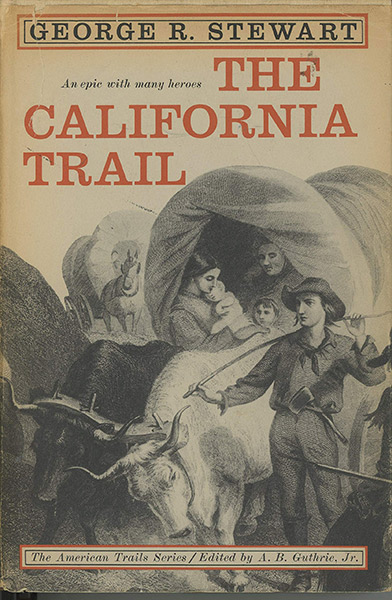George R. Stewart, The California Trail (McGraw Hill, 1962)
 This book details the story of the California Trail from 1841 to 1849. Each chapter is a year-by-year survey of the emigrants, with a couple of general chapters interspersed (which he calls “interchapters”). The chapters for 1846 (Donner Party) and 1849 (Gold Rush) are particularly long and detailed. At the end, he sums up the emigration years 1850-59 in one chapter.
This book details the story of the California Trail from 1841 to 1849. Each chapter is a year-by-year survey of the emigrants, with a couple of general chapters interspersed (which he calls “interchapters”). The chapters for 1846 (Donner Party) and 1849 (Gold Rush) are particularly long and detailed. At the end, he sums up the emigration years 1850-59 in one chapter.
The book is written in the “popular history” style. That is, while the author is incredibly knowledgeable and includes myriad details and facts, there are no footnotes and no bibliography. The style is also, at times, very folksy. For instance, the Introduction (“Proem”) starts out, “First of all, let us remember a far-off land with the strange name California.” Another example is in Interchapter Two (“Where They Went”), where he breaks the trail down into sections and describes what emigrants would see and how they’d be faring at that part in the journey, mostly using second person. “Although both St. Joseph and Council Bluffs were being used, you could still consider Independence the conventional point of departure. You would set out, generally, in early May. Over the first fifty miles you followed the well-worn Santa Fe Trail . . .”
At first, I worried that the book might be too dumbed down to be worth reading. Rather, the author excels at story telling, which makes the book entertaining as well as informative. The first few years of emigration had so few people and parties that he talks about many of them as individuals, and tells the story of the trail as a story rather than a straight recitation of facts and timeline. At some point, the book picked up the subtitle “An epic with many heroes,” and that is a good summation of the author’s approach. The book also includes straightforward map drawings showing different cutoffs and when they were opened. And Interchapter One includes information on details such as what types of wood went in the different parts of the wagons, how to ford a stream, and how to pull a wagon up a hill too steep for a team of ox.
Altogether, it makes the book a misleadingly light, quick read.